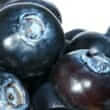Background
- Bilberry, a close relative of blueberry, has a long history of medicinal use. The dried fruit has been popular for the symptomatic treatment of diarrhea, for topical relief of minor mucus membrane inflammation, and for a variety of eye disorders, including poor night vision, eyestrain, and myopia.
- Bilberry fruit and its extracts contain a number of biologically active components, including a class of compounds called anthocyanosides. These have been the focus of recent research in Europe.
- Bilberry extract has been evaluated for efficacy as an antioxidant, mucostimulant, hypoglycemic, anti-inflammatory, "vasoprotectant," and lipid-lowering agent. Although pre-clinical studies have been promising, human data are limited and largely of poor quality. At this time, there is not sufficient evidence in support of (or against) the use of bilberry for most indications. Notably, the evidence suggests a lack of benefit of bilberry for the improvement of night vision.
- Bilberry is commonly used to make jams, pies, cobblers, syrups, and alcoholic/non-alcoholic beverages. Fruit extracts are used as a coloring agent in wines.
References
Natural Standard developed the above evidence-based information based on a thorough systematic review of the available scientific articles. For comprehensive information about alternative and complementary therapies on the professional level, go to . Selected references are listed below.
- Bomser J, Madhavi DL, Singletary K, et al. In vitro anticancer activity of fruit extracts from Vaccinium species. Planta Med 1996;62(3):212-216.
View Abstract - Canter PH, Ernst E. Anthocyanosides of Vaccinium myrtillus (bilberry) for night vision--a systematic review of placebo-controlled trials. Surv.Ophthalmol 2004;49(1):38-50.
View Abstract - Erlund I, Marniemi J, Hakala P, et al. Consumption of black currants, lingonberries and bilberries increases serum quercetin concentrations. Eur.J Clin Nutr 2003;57(1):37-42.
View Abstract - Head KA. Natural therapies for ocular disorders, part two: cataracts and glaucoma. Altern Med Rev 2001;6(2):141-166.
View Abstract - Hou DX. Potential mechanisms of cancer chemoprevention by anthocyanins. Curr Mol Med 2003;3(2):149-159.
View Abstract - Katsube N, Iwashita K, Tsushida T, et al. Induction of apoptosis in cancer cells by Bilberry (Vaccinium myrtillus) and the anthocyanins. J Agric Food Chem 1-1-2003;51(1):68-75.
View Abstract - Kramer JH. Anthocyanosides of Vaccinium myrtillus (bilberry) for night vision--a systematic review of placebo-controlled trials. Surv.Ophthalmol 2004;49(6):618.
View Abstract - Levy Y, Glovinsky Y. The effect of anthocyanosides on night vision. Eye 1998;12 ( Pt 6):967-969.
View Abstract - Logan AC, Wong C. Chronic fatigue syndrome: oxidative stress and dietary modifications. Altern.Med Rev 2001;6(5):450-459.
View Abstract - Lyons MM, Yu C, Toma RB, et al. Resveratrol in raw and baked blueberries and bilberries. J Agric.Food Chem. 9-24-2003;51(20):5867-5870.
View Abstract - Milbury PE, Graf B, Curran-Celentano, JM, et al. Bilberry (Vaccinium myrtillus) anthocyanins modulate heme oxygenase-1 and glutathione S-transferase-pi expression in ARPE-19 cells. Invest Ophthalmol Vis Sci 2007;48(5):2343-2349.
View Abstract - Muth ER, Laurent JM, Jasper P. The effect of bilberry nutritional supplementation on night visual acuity and contrast sensitivity. Altern Med Rev 2000;5(2):164-173.
View Abstract - Rasetti FRM, Caruso D, Galli G, et al. Extracts of Ginkgo biloba L. leaves and Vaccinium myrtillus L. fruits prevent photo induced oxidation of low density lipoprotein cholesterol. Phytomedicine 1997;3:335-338.
- Roy S, Khanna S, Alessio HM. et al. Anti-angiogenic property of edible berries. Free Radic Res 2002;36(9):1023-1031.
View Abstract - Zadok D, Levy Y, Glovinsky Y. The effect of anthocyanosides in a multiple oral dose on night vision. Eye 1999;13 ( Pt 6):734-736.
View Abstract







